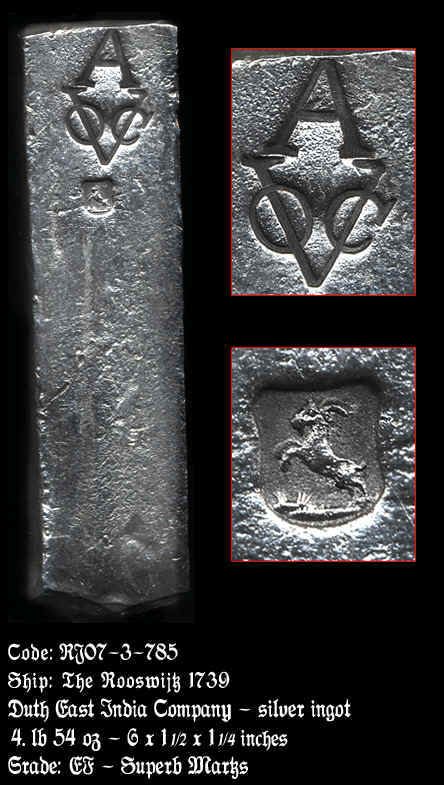
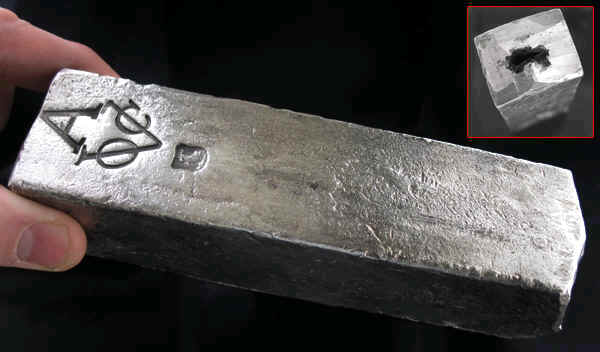
Note: This silver bar had been on a Dutch East India Company ship "Rooswijk" that sank in a storm in the English Channel in 1739. These silver bars had been mined in Mexico that at that time was rules by Spain. Initially it had been carried by Spanish vessels from Mexico to Cadiz, later the silver sold to the Dutch and shipped to Holland, where it had been melted down and converted into silver bars bearing the mark of the Amsterdam Chamber of the Dutch East India Co. and the assayers or Foundry mark depicting a goat, which relation to an specific name is still unknown. The re-stamped treasure was then loaded onto the Rooswijk, bound for Batavia.
These bars were made of other bars and silver coins and paradoxically would have been remelted down to produce coinage if the vessel had not sunk. In conclusion the uniqueness of this "transitory" form of silver bullion is highly appreciated by collectors around the world.
This Genuine Silver Ingot comes with 2 Certificates of Authenticity one issued by R. E. Bryson (Deputy Project Administrator) and the other Certificate is issued by Historic Real Treasures. In addition you will get a letter about all the transitional type of coins minted in 1733. A package that you won't find anywhere else!
The Rooswijk: During late December 1739 the Rooswijk, one of the retour ships of the Dutch East India Company was ready for its second long journey to the Indies. Accountants and officials of the company supervised the loading of 30 chests of silver coins minted primarily in Mexico. Each pine chest was wrapped in canvas, tied with rope, and sealed in red wax with the personal seal of the captain. The journey was ill fated from the beginning, and the Rooswijk struck the treacherous Goodwin Sands off the South East coast of England in a heavy storm. The weather that winter was so bad that the wreck site was unapproachable and the remains of the Rooswijk lay covered in many feet of sand for another 265 years. In December 2005, it was made public that between May and September of that year a team led by Rex Cowan had recovered some of the ship and its contents. This was done in secrecy to avoid attracting looters. Lying at a depth of about 24 m, the Rooswijk was discovered by an amateur diver in 2004. The numismatic Treasures recovered from the Rooswijk Shipwreck offer a rare opportunity to better study and understand coinage of this period. What makes this shipwreck and discovery so unique is that the coins that were recovered are from a transitional period in the history of the Mexico City Mint. In the early 1730's, the introduction of new minting equipment lead to the gradual phasing out of older coining methods, numerous different coinage types and varieties came together. In 1733 the mint produced more different types and varieties of 8 Reales than in any other single year. Four major different types of these were: cobs, cobs struck with "Klippe" dies, Klippes and the Milled "Pillar Dollar". 1733 marked the end of the "Cob" coinage production. One remarkable detail about the Spanish Colonial coinage is that 8 Reales or "pillar dollars", minted in Mexico City, circulated in The United States of America as legal tender until 1857.
Ship: The Rooswijk 1739
Type: Amsterdam Mint Silver Ingot
Details: Total weight 4LB 54 Oz.
Measurements: 6 x 11/2 x 11/4 inches
Reign: Philip V - Date: Circa 1739.
Mint: Amsterdam - Assayer: Is unknown, Foundry mark: Goat in shield and Mark of Amsterdam Chamber of the VOC (Dutch East India Company) . The VOC consisted of six Chambers (Kamers) in port cities: Amsterdam, Delft, Rotterdam, Enkhuizen, Middelburg and Hoorn. Delegates of these chambers convened as the Heeren XVII (the Lords Seventeen)
Code: RJ07-3-785 - Extremely fine condition and deep dark markings.
US $6.195,00, (EUR 4.493,04), juli 2007, ebay, shipwreckcoins
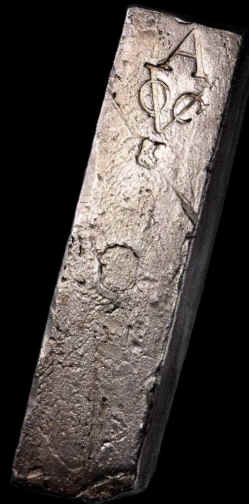
Prachtig. euro 4.600, excl 20% opgeld, april 2010, Schulman lot 246 .
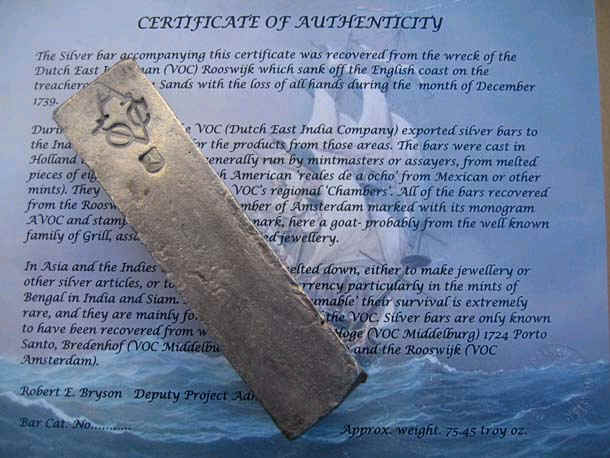
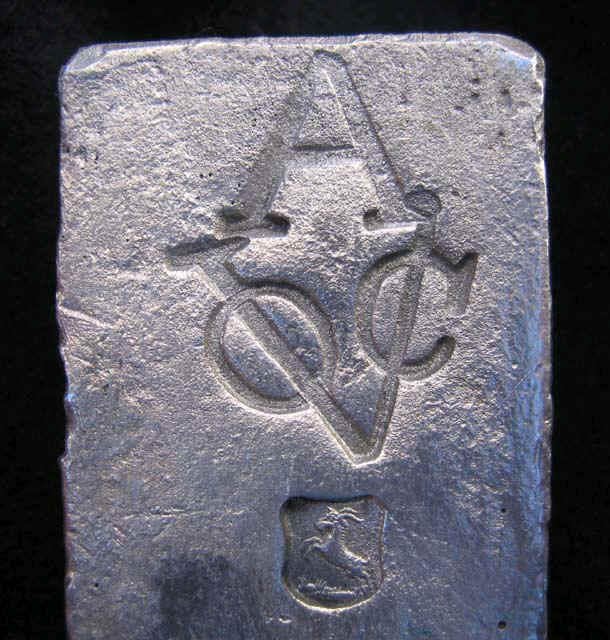
In terms of markings, the Rooswijk bars are easy to decipher, but there is one mystery. At the top of the bar a large A announces the VOC Chamber (province) that issued the bar, in this case, Amsterdam. Immediately below the A we have the logo of the Dutch East Company, an interlocking set of three letters, VOC, standing for the Vereenigde OostIndische Compagnie. Next comes the unexplained item. In a small intaglio cartouche we see a rampant billygoat (geitebok) springing across a grassy plain. By Dutch law a silver ingot had to marked by the party responsible for refining it, so this must be the assayer's mark, although no Dutch assayer of the period owns up to the title of "Miijheer Willem Geitebok." Ongoing research by Dr .
Arent Pol in the Netherlands may shortly disclose who "Mr Billy Goat" was.
The dimensions of the bar are approximately 6.5" x 1.5" x 1.25".
Currently for sale at $3675 (euro 2758)
terravitan@aol.com or 480-595-1293

SOLD 2,900.00USD to windward163 + (522.00) buyer's premium + taxes, fees, etc... at 2009 Oct 16 (ca euro 2566)

SOLD 2,900.00USD to brodsr + (522.00) buyer's premium + taxes, fees, etc... at 2009 Oct 16 (ca euro 2566)
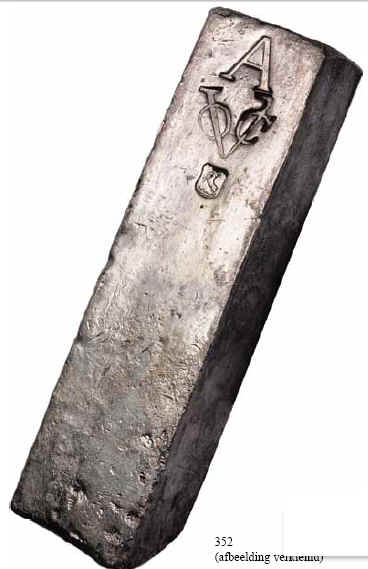
Schulman, lot 352, 1 dec. 2012, euro 2.500 excl. 20% opgeld
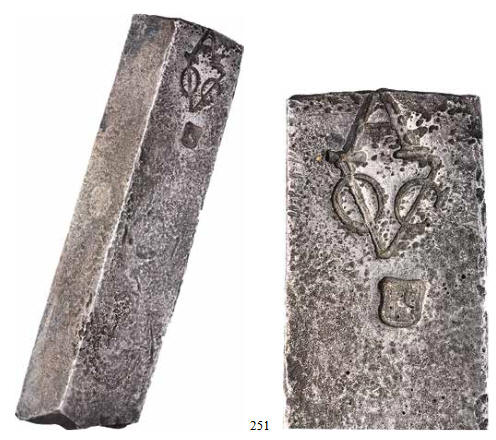
Schulman b.v., nov. 2017, lot 251, euro 2880